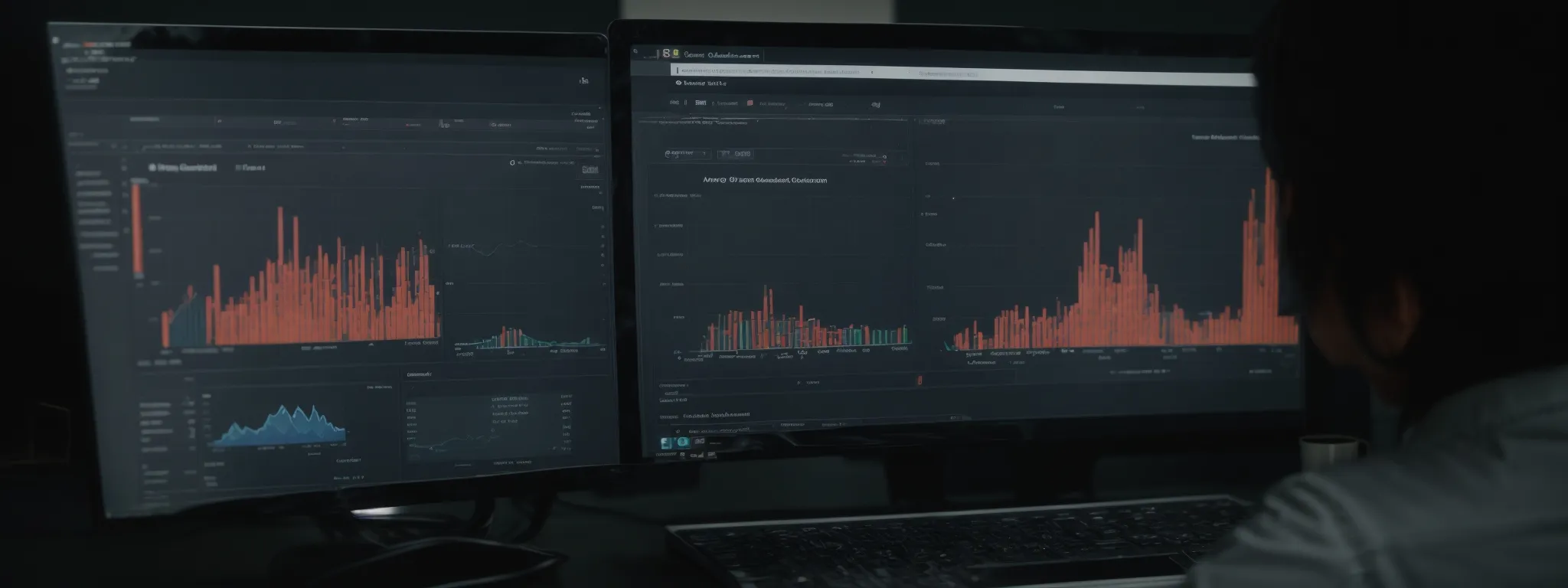Optimize SEO with Header Div Strategies
Mastering Header Div Strategies for Enhanced SEO Performance In a meticulously constructed HTML document, header tags are not just aesthetic elements; they are essential for Search Engine […]
Mastering Header Div Strategies for Enhanced SEO Performance
In a meticulously constructed HTML document, header tags are not just aesthetic elements; they are essential for Search Engine Optimization.
These HTML tags, ranging from H1 to H6, form a hierarchy that tells search engines about the relevance and interconnectivity of the content blocks on a web page.
By optimizing these headers, webmasters and authors can significantly enhance their site’s visibility and ranking.
Effective header strategies ensure that Googlebot and other search engines can navigate through the text effortlessly, grasping the main ideas and thus, ranking the page accordingly.
Keep reading to discover how the mastery of header div strategies can advance your website’s SEO performance.
Key Takeaways
- Header Tags Are Critical for Content Hierarchy and Influence Both Search Engine Indexing and User Experience
- LinkGraph Utilizes Strategic SEO Practices to Optimize Header Tags, Enhancing Webpage Visibility and Engagement
- Accessibility and Schema Markup Within Header Tags Improve SEO and User Navigation, Expanding Audience Reach
- Robust Analytics and a/B Testing Are Essential to Measure the Impact of Header Tag Optimization on SEO Performance
- SearchAtlas SEO Tools Provided by LinkGraph Enable Meticulous Evaluation and Enhancement of Header Structures
Understanding the Importance of Header Tags for SEO

The architecture of a web page is fundamental for both search engines and users, and header tags, such as the H1, H2, and H3, form the keystone of this architecture.
These HTML elements serve as signposts, guiding Googlebot and other search engine crawlers through the content hierarchy, and they help in compartmentalizing information into digestible blocks for readers’ convenience.
As webmasters and authors craft their content, understanding and leveraging the power of header tags not only advances the clarity and structure of the document but also enhances the user experience.
By dissecting the role of these pivotal HTML tags, one can uncover their significant impact on search engine algorithms, content structure, and ultimately, the satisfaction of the user navigating through a sea of information.
The Role of Header Tags in Search Engine Algorithms
Within the realm of search engine optimization, header tags contribute substantially to the indexing and ranking process of search engines. These HTML tags are akin to the chapters of a book, providing structure and context to the content, enabling search engines to discern the relevance and organization of the material.
When utilized effectively, header tags have the capacity to bolster a web page’s visibility in search engine results. This is due to their role in emphasizing key topics and ideas central to the page’s content, enhancing the document’s overall searchability:
- Header tags frame the main points, allowing search engines to quickly identify and evaluate the page’s subject matter.
- The consistent use of headers aids algorithms in recognizing content hierarchies, thereby evaluating content significance.
- Proper header application can increase a web page’s semantic richness, improving its potential to match varied search queries.
Search engines, like Google, grant a weight of importance to header tags as part of their ranking criteria, with the H1 tag typically carrying the most weight. Thus, mastering the use of header tags is not merely a component of good HTML structure but a strategic element in search engine recognition and user navigation alike.
How Header Tags Influence Content Structure
Header tags effectively orchestrate the flow of a content block, offering readers visual cues and breakpoints within an otherwise monolithic text. By incorporating H1, H2, and other headers appropriately, authors establish a logical progression of ideas, allowing users to navigate a web page without feeling overwhelmed by dense paragraphs.
An intelligently structured document employs headers to segregate notions into manageable units, which in turn facilitates comprehension and retention for the reader. Web pages that excel in this regard not only retain visitors but also encourage engagement, as ease of readability is directly linked to user satisfaction and interaction:
| Header Tag | Role in Content Structure | Impact on User Experience |
|---|---|---|
| H1 | Signifies the main title or primary focus | Clarifies the topic, anchoring user expectations |
| H2 | Denotes subsections under the main header | Breaks content into identifiable sections, aiding navigation |
| H3 | Highlights subtopics or points within H2 sections | Further details content, enhancing comprehension and interest |
The Impact of Header Tags on User Experience
Immaculately placed header tags transform the user’s journey through a web page by establishing a clear path to follow. They act as landmarks that distinguish vital content, allowing a visitor to skim through sections effortlessly or delve deep into specific topics of interest, thereby generating an interactive user experience that resonates with the individual’s search intentions.
Header tags significantly impact the readability and approachability of online content; H1 tags serve as a content cornerstone, immediately informing readers of the broader context, while subsequent headings draw them deeper into the material. This meticulous guidance helps maintain user engagement, reflecting positively on the site’s user metrics, a factor highly regarded by search engines.
Crafting Effective H1 Tags for Strong SEO Foundations

As digital real estate on the web becomes increasingly competitive, the necessity for strategic search engine optimization is paramount.
At the center of effective SEO, the H1 tag stands as a beacon to both search engines and readers, highlighting the crux of a web page’s content.
An expertly crafted H1 tag strikes an essential balance between incorporating targeted keywords for search algorithms and providing clear, engaging text for readers.
In this article, industry leaders are equipped with best practices for formulating compelling H1 tags, insights into harmonizing SEO goals with reader accessibility, and wisdom to sidestep common pitfalls that could undermine the potency of this pivotal HTML element.
A well-executed H1 tag lays the groundwork for a page’s SEO success and serves as an invitation to engage users with quality, relevant content.
Best Practices for Creating Compelling H1 Tags
In crafting H1 tags, LinkGraph’s SEO services emphasize originality and precision. A compelling H1 tag encapsulates the essence of the page’s content in a succinct, keyword-rich header that captures the attention of both users and search engines alike.
Utilizing LinkGraph’s SearchAtlas SEO tool, professionals meticulously analyze and select keywords that not only align with search intent but also blend seamlessly into the H1 tag. This ensures that the tag acts as an authoritative signal, bolstering the relevance and discoverability of the web page.
Balancing SEO and Readability in H1 Tags
In the intricate dance of search engine optimization, striking equilibrium between SEO efficacy and the reader’s ease of comprehension is critical. LinkGraph’s SEO services understand that an H1 tag must resonate with search engines by integrating strategic keywords while simultaneously engaging the reader with clear and accessible language. This dual focus ensures that the H1 tag functions as a welcoming entry point to the content and a robust anchor for SEO performance.
Adhering to a reader-centric approach, LinkGraph champions the importance of readability in H1 headers, ensuring that these pivots in the content landscape retain a natural tone. The service’s foresight in avoiding jarring, keyword-stuffed phrases allows for an organic alignment with users’ interests and search behaviors:
- Create H1 tags that reflect user search intent and provide immediate value.
- Integrate relevant keywords naturally to maintain readability.
- Ensure clarity in H1 tags to facilitate quick understanding and content navigation.
Common Mistakes to Avoid With H1 Tags
In the quest to perfect search engine optimization, one common misstep involves neglecting the uniqueness of the H1 tag across various pages. Webmasters must resist the temptation to duplicate H1 content throughout a website, as unique headers on each page signal distinct and valuable content to search engines, driving better indexing and user relevance.
An overly generic H1 tag fails to capture the specificity and focus of the page’s content, potentially diluting its effectiveness both for the user seeking information and the algorithms that determine search rankings. Ensuring that the H1 tag is both precise and descriptive acts as a cornerstone of a strong SEO strategy:
- Every H1 tag should be distinct to avoid diminishing search engine clarity and user engagement.
- Avoid vague headers; instead, optimize H1 tags with targeted keywords that concisely communicate the page’s subject.
- Resist creating H1 tags that are overly long or filled with multiple keywords, which can diminish readability and weaken SEO impact.
Leveraging H2 and H3 Tags for Topic Hierarchy

Successfully navigating the intricate landscape of Search Engine Optimization requires a robust understanding of how to employ header tags beyond the primary H1.
Subsequent headers, namely H2 and H3, play a pivotal role in elaborating topic hierarchy, enriching content with meaningful structure that search engines and readers appreciate.
In the quest for clarity within a web page’s narrative, a strategic approach to structuring content with these subheadings is imperative.
This includes the judicious use of keywords and the implementation of best practices to ensure a logical flow of information.
As such, it is vital for digital content creators to master the nuances of H2 and H3 usage to advance the clarity, readability, and SEO performance of their documents.
Structuring Content With Subheadings for Clarity
Implementing H2 and H3 tags not only enhances a web page’s SEO performance but also sharpens the precision with which information is structured. Through judiciously applied subheadings, LinkGraph’s SEO services ensure that web content is meticulously segmented, fostering a streamlined user experience and facilitating the absorption of key points.
Subheadings serve as navigational anchors within the content, enabling a user to scan for topics that resonate with their needs. LinkGraph recognizes the pivotal role these HTML elements play in demarcating content, thereby refining a document’s layout and bolstering its accessibility for both users and search engines alike.
Using Keywords Strategically in H2 and H3 Tags
LinkGraph’s approach to optimizing H2 and H3 tags hinges on the strategic placement of keywords to draw a clear line between general concepts and niche topics. By embedding targeted keywords within these subheadings, the relevance of the content is magnified, aligning with specific user queries and enhancing the visibility of web pages on search engines.
Ensuring that H2 and H3 tags not only serve as signposts for content structure but also as signal boosters for search engine algorithms is a delicate balance that LinkGraph deftly achieves. Their expertise in the nuances of keyword distribution within header tags significantly elevates a page’s SEO profile, directly impacting its hierarchical standing in SERPs.
Tips for Maintaining a Logical Content Flow
A logical content flow is pivotal in keeping readers engaged and conveying information clearly. To achieve this, LinkGraph’s SEO experts recommend outlining a document’s structure before diving into writing, ensuring each section naturally progresses to the next: a practice that serves both user understanding and search engine indexing efficiently.
| Header Tag Usage | Role in Content Logic | Benefits to SEO |
|---|---|---|
| Strategic Keyword Insertion in H2, H3 | Organizes topics and subtopics coherently | Enhances search relevance and categorization |
| Logical Transition Between Headers | Ensures a smooth flow and narrative integrity | Increases reader engagement and time on site |
By judiciously deploying h2 and h3 tags, LinkGraph’s SEO services create a clear hierarchy within content, making it easy for users to follow and for search engines to map out the relevance. This approach sees each section build upon the last, maintaining continuity and direction throughout the document, resulting in an enhanced reading experience that can translate into improved search rankings.
Optimizing Header Tags to Boost Organic Search Visibility

In a digital landscape where visibility is paramount, harnessing the potential of header tags stands as an essential tactic in the arsenal of SEO professionals.
The strategic optimization of header tags—often understated but undeniably potent—can lead to marked improvements in a website’s organic reach.
By exploring techniques that refine header tags for search engine appreciation and dissecting the attributes that make top-ranking pages successful, one can unlock new echelons of search performance.
Tools designed specifically for auditing and enhancing a site’s header tag strategy are invaluable in this initiative, empowering maintainers to elevate their web page’s standing on the search engine results pages (SERPs).
This pursuit of optimized header tag deployment not only aligns with SEO best practices but also paves the way for more nuanced and effective content strategies.
Techniques for Enhancing Header Tags With SEO in Mind
LinkGraph’s SEO specialists prioritize precision in header tag usage, tailoring each to enhance a document’s relevance to targeted search queries. Their approach emphasizes the infusion of pertinent keywords into headers like the H1, H2, and H3, increasing the alignment with user intent while safeguarding against indiscriminate keyword stuffing that could hinder readability and search rankings.
In advancing the craft of header tag optimization, LinkGraph’s services utilize comprehensive SEO tools from their SearchAtlas suite. This enables a meticulous evaluation and refinement of header tags to elevate a web page’s interpretability by search engine algorithms, thereby improving its organic visibility and advancing its authority within the digital domain.
Analyzing the Header Tags of Top-Ranking Pages
Analyzing the header tags of top-ranking pages reveals insights into the correlation between structured data and search engine success. LinkGraph’s SEO experts scrutinize these elements, gleaning patterns and strategies that consistently lead to higher SERP positions.
This analysis uncovers the sophistication with which successful pages utilize H1, H2, and H3 tags in delineating content hierarchy, a practice underpinning their SEO triumph. Revealing more than just intelligent keyword usage, top-ranking pages demonstrate the impactful union of user-centric design and search engine-focused structuring:
- Investigation of H1 tag positioning and keyword integration for topic dominance.
- Scrutiny of H2 tags as a means to emphasize important subtopics and themes.
- Inspection of H3 tags for their role in clarifying detailed points, adding depth to the narrative.
The strategic use of header tags by the top-performing web pages acts as an invaluable blueprint for others aiming for SEO excellence, with LinkGraph’s services meticulously applying these powerful insights to their client’s websites for an optimized online presence.
Tools to Help Audit and Optimize Your Header Strategy
To refine the efficacy of header tags, utilizing specialized tools is critical in auditing and optimizing a website’s SEO framework. LinkGraph’s SearchAtlas tool provides robust functionality to diagnose and enhance header structures, enabling webmasters to pinpoint weaknesses and capitalize on optimization opportunities.
With these powerful tools, professionals can systematically evaluate the performance of their header tags, ensuring they align with targeted keywords and adhere to the latest SEO guidelines. This fosters a rapid advancement in organic search standing, as targeted improvements to header tags correlate with improved ranking potential:
- Conduct thorough header tag analysis for optimizing page structure and keyword relevance.
- Implement recommendations from SEO tools to fortify header efficiency and SERP authority.
- Monitor ongoing performance to refine and update header tags as search algorithms evolve.
Header Tag Accessibility and Its SEO Benefits

In the endeavor to secure higher SEO rankings, professional digital strategists recognize that optimizing header tags extends beyond conventional keyword placement to encompass accessibility standards.
Ensuring that header tags such as H1, H2, and H3 are accessible to all users, including those with disabilities, not only adheres to ethical and legal directives but also contributes positively to SEO performance.
Delving into the symbiotic relationship between web accessibility and search rankings illuminates a pivotal aspect of modern SEO strategies.
Furthermore, the implementation of schema markup within header tags presents an opportunity to communicate the structure and meaning of web content more effectively to search engines.
This strategic alignment forms a comprehensive approach that advances the visibility and integrity of web pages within the realm of search engine algorithms.
Ensuring Header Tags Meet Accessibility Standards
LinkGraph’s dedication to SEO includes a strong focus on the accessibility of header tags. This commitment elevates a page’s usability across diverse audiences, simultaneously complying with W3C guidelines and boosting a page’s search rankings through increased user interactions and dwell time.
Through thoughtful implementation, LinkGraph ensures that header tags are not only semantic landmarks but also accessible entry points to the content for users with assistive technologies. In doing so, these optimized header tags not only refine user experience but also fortify the site’s SEO infrastructure in the digital ecosystem.
The Relationship Between Accessibility and SEO Rankings
Accessibility in header tag design is crucial for better search rankings, as it allows search engines to more accurately interpret and rank web content. Search engines like Google emphasize user experience, rewarding sites with accessible features, including properly structured header tags, which facilitate content understanding for all users.
Implementing accessible header practices not only benefits individuals with disabilities but also enhances SEO by enabling search engines to navigate a site’s architecture with greater ease. This approach supports a wider audience reach and contributes to an improved ranking on search engine results pages, affirming the significance of inclusive design in modern SEO strategies.
- Accessible header tags lead to improved content interpretation by search engines.
- Enhanced navigation aids search engine crawling and content ranking.
- Inclusive design practices expand audience reach and promote user satisfaction.
Implementing Schema Markup With Header Tags
LinkGraph strides ahead in the search engine optimization arena by integrating schema markup within header tags, a stratagem that amplifies the comprehension engines like Google have of a web page’s structure. This sophisticated application of schema reinforces the semantic meaning behind the headers, thereby sharpening the search engine’s grasp and the resulting rankings affiliated with the tagged content.
Through the lens of augmented indexing prowess, the implementation of schema markup extends its utility from search engine visibility to user engagement. By making header tags more informative to search engine crawlers, LinkGraph enhances the likelihood of rich results, which can catapult a webpage’s prominence on the search engine results pages, driving organic traffic and fostering user interactions.
Monitoring and Measuring the Impact of Header Tag Optimization

In the pursuit of SEO mastery, the scrutiny of header tag efficacy becomes a critical analytical endeavor, bridging the gap between theoretical optimization and measurable outcomes.
Firms looking to refine their web presence must establish robust analytics to monitor header tag performance, yielding insights that are actionable and grounded in data.
With an astute interpretation of this data, companies can iterate their header tag strategies, focusing on granular adjustments that resonate with their audience.
Moreover, engaging in rigorous A/B testing uncovers the nuances in header tag variations that most effectively capture user attention and drive engagement, thereby solidifying the foundation of a strong SEO strategy.
Setting Up Analytics to Track Header Tag Performance
Effective measurement stands as the cornerstone of any SEO strategy, and for those seeking to optimize header tags, setting up the right analytics tools is critical. Professionals use advanced tracking systems to observe how modifications in header tags affect page performance, which includes alterations in user engagement and search rankings over time.
By configuring analytics to capture key metrics associated with header utilization, SEO experts from LinkGraph can discern the direct influence of H1, H2, and H3 adjustments on a site’s SEO trajectory. This precise data collection allows for informed decision-making and further fine-tuning of header strategies to ensure peak search engine visibility and user engagement.
Interpreting Data to Refine Header Tag Strategy
In a landscape teeming with data-driven strategies, interpreting the outcomes of header tag revisions is pivotal for shaping an astute SEO roadmap. Mastery in this domain entails analyzing user behavior metrics like bounce rates and time on page, unveiling the influence of header tag structures on user engagement and search relevancy.
The intelligence gleaned from performance analytics provides imperative feedback, enhancing the precision of header tag tactics. Leveraging this data, professionals at LinkGraph refine their header strategies, optimizing tags to serve both the user’s pursuit of information and the search engine’s need for content hierarchy:
- Examine the relationship between header tag changes and fluctuations in organic traffic.
- Assess the impact of header adjustments on page ranking positions across various search engines.
- Adjust header compositions based on deep dives into click-through rates and engagement levels post-implementation.
A/B Testing Header Tags to Find What Works Best
A/B testing stands out as a crucial technique employed by LinkGraph’s SEO specialists to pinpoint the most effective header tags. By presenting variant headers to different user segments, they can directly observe which combinations yield the best engagement and conversion rates, thereby tailoring content to the audience’s preferences and search engine criteria.
Through rigorous experimentation and analysis, the impact of nuanced changes in header tags are quantified, allowing for strategic refinements. This methodical approach amplifies the efficacy of SEO efforts, as LinkGraph meticulously optimizes header tags to bolster a web page’s prominence and user interaction in the search engine landscape.
Conclusion
Mastering header tag strategies is crucial for enhancing SEO performance.
By implementing well-structured H1, H2, and H3 tags, we give a clear hierarchy to web content, making it easier for search engines to index and rank pages while improving the user experience.
Integrating relevant keywords into these headers, without overstuffing, aligns with user search intent and can lead to better visibility in search results.
Additionally, ensuring headers meet accessibility standards not only serves a wider audience but also positively impacts SEO rankings.
Tools such as LinkGraph’s SearchAtlas can audit and optimize header strategies, further boosting a site’s SEO.
Ultimately, the careful use of header tags is a key element in a successful SEO strategy, helping to drive organic traffic and increase user engagement.















































































